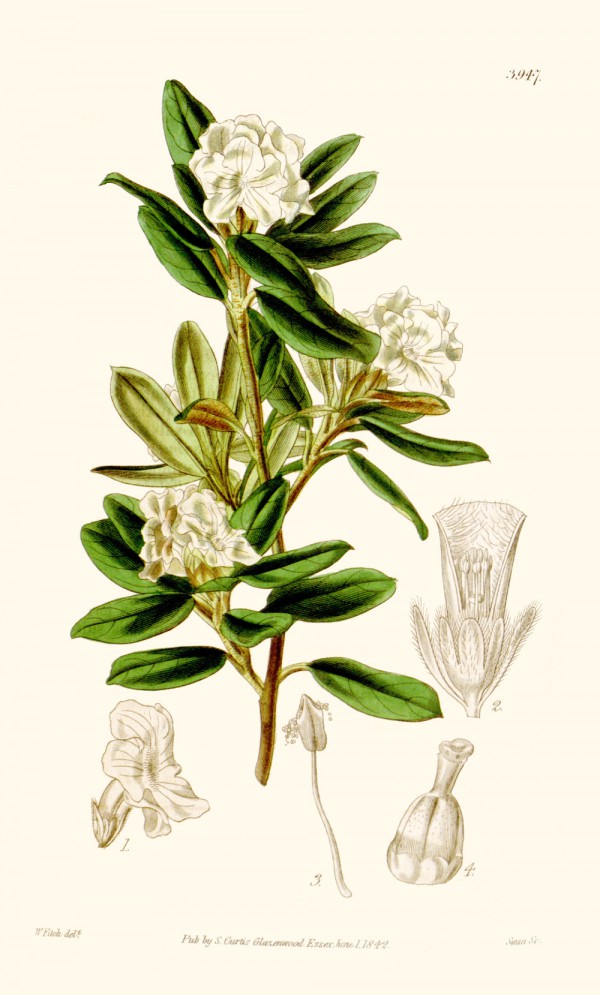Rhododendron anthopogon D.Don - syn. Rhododendron hypenanthum Balf. f. - Ericaceae
dwarf rhododendron
Small evergreen shrub, up to 1.50m tall, native to Nepal, Northern India, Bhutan, China (S Xizang); leaves strongly aromatic, simple, alternate, short stalked, oval to ovate, 2.5-4 cm long, densely scaly beneath; inflorescence 4-6(-9)-flowered; corolla narrowly tubular-funnelform, pink, or yellowish white, tube 6-12mm long; capsule ovoid, 3-5mm.
http://www.efloras.org/florataxon.aspx?flora_id=2&taxon_id=200016332
https://npgsweb.ars-grin.gov/gringlobal/taxonomydetail.aspx?id=418051
https://sites.google.com/site/efloraofindia/species/a---l/e/ericaceae/rhododendron/rhododendron-anthopogon
Anthopogon oil is obtained by steam distillation of the aerial part of Rhododendron anthopogon. It is a pale yellow fluid liquid with sweet herbal, faint balsamic scent. „Leaves are aromatic, stimulant and also administered to produce sneezing. Its decoction is used in cold, cough and chronic bronchitis.“
http://www.biosysnepal.com.np/product/oil/anthopogon.php
The essential oil of the leaves owns „…a sweet, fresh, and light aroma. Use for respiratory or for the beautiful scent.“
Main components of commerical oils were α-pinene (28.3-30.9%), β-pinene (12.1-13.1%), limonene (7.0-10.7%), δ-cadinene (9.0-9.5%), and β-caryophyllene (2.6-3.6%).
[Pompeii Organics, Rhododendron, GCMS of two batches given, retrieved 2018/01/16] https://pompeiiorganics.com/rhododendron/
„The oil was characterized by a high amount of monoterpene hydrocarbons (76.1%), mainly α-pinene (37.4%), followed by β-pinene (16.1%), limonene (13.3%), and the sesquiterpene, δ-cadinene (9.1%). The composition of R. anthopogon essential oil was quite different from those of other Rhododendron species: the main components of R. nivale essential oil are δ-cadinene and α-cadinol, whereas β-pinene, camphene and δ-3-carene are the major constituents of the oil of R.mucronulatum. The composition of R. anthopogonoides essential oil is also totally different; infact, its main components are benzylacetone and selina-3,7-diene. Furthermore, studies on essential oils from leaves of R. dauricum and R. aureum found that the dominant compounds were trans-caryophyllene and calarene, respectively.“
[Innocenti, Gabbriella, et al. „Chemical composition and biological properties of Rhododendron anthopogon essential oil.“ Molecules 15.4 (2010): 2326-2338]

Curtis’s Botanical Magazine, t. 3880-3963, vol.68 ser.2 vol.15 t.3947 (1842) [W.H.Fitch]
http://botanicalillustrations.org/species.php?id_species=875684
Video:
Source - flowersofindia.net This footage is part of the professionally-shot broadcast stock footage archive of Wilderness Films India Ltd.
„One of the smallest flowering Rhododendron shrubs - the talispatra, as seen above Dodital in May 1994, in Uttarakhand, India, at around 12, 500 feet altitude. The anthopogon is one of the chief aromatic ingredients of a Hindu prayer ceremony with the havan samigri comprising of dried leaves of this species. This is probably one of the smallest of rhododendrons. Grows to no more that 2-3 ft high. The white or yellow flowers, tinged with pink, grow in small compact clusters of 4-6 and each flower is 2 cm across. The dark green oval leaves are strongly aromatic and densely scaly underneath. The leaves are mixed with Juniper and used as incense in Buddhist monastries as well as in Hindu religious ceremonies. This species is globally distributed in the Himalayan range across Pakistan, India, Nepal, Bhutan and SE Tibet between an altitude range of 3000-4800 m. Within India, it has been recorded in Jammu & Kashmir, Himachal Pradesh, Uttar Pradesh, Sikkim and Arunachal Pradesh. Medicinal uses: [Warning: Unverified information] In Nepal, Dwarf Rhododendron is used in making an essential oil. Anthopogon oil, as it is usually referred to in Nepal, is obtained by steam distillation of the aerial part of this shrub. It is a fluid liquid of pale yellow colour and sweet-herbal, faintly balsamic aroma. Rhododendron can be used in gouty rheumatic conditions. The essential oil is a stimulant and affects fibrous tissue, bones and nervous system.“